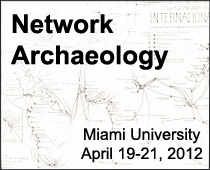Category Archives: Panel: Archaeologies of (Media) Distribution

Half-Inch Revolution: Guerrilla Television’s Tape Networks
Presentation by Kris Paulsen (The Ohio State University). The Rays, a 1970 videotape by the Raindance Corporation, shows something curious: As the three collaborators record each other, rhythmic waves flow across the screen. In each wave there are bits of

Half-Inch Revolution: Guerrilla Television’s Tape Networks
Presentation by Kris Paulsen (The Ohio State University). The Rays, a 1970 videotape by the Raindance Corporation, shows something curious: As the three collaborators record each other, rhythmic waves flow across the screen. In each wave there are bits of

Divining the Network With the Forked Twig: An Archaeological Approach to Locative Media
Presentation by Alex M. Ingersoll (University of North Carolina, Chapel Hill). Locative media and augmented reality applications are part of an increasingly popular group of digital technologies that determine a user’s or object’s physical, geographical position and then provide an

Divining the Network With the Forked Twig: An Archaeological Approach to Locative Media
Presentation by Alex M. Ingersoll (University of North Carolina, Chapel Hill). Locative media and augmented reality applications are part of an increasingly popular group of digital technologies that determine a user’s or object’s physical, geographical position and then provide an

Photographic Continuities
Presentation by Brooke Beslile (UC Berkeley). Contemporary theorists tend to describe globalized media culture as subtended by contemporary technologies such as digital networks and satellite communications. Globalization itself is often historicized alongside the rise of computing and the ‘information age.’

Photographic Continuities
Presentation by Brooke Beslile (UC Berkeley). Contemporary theorists tend to describe globalized media culture as subtended by contemporary technologies such as digital networks and satellite communications. Globalization itself is often historicized alongside the rise of computing and the ‘information age.’


